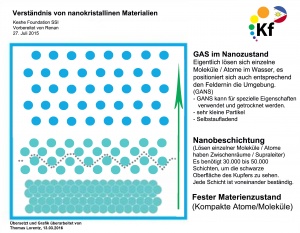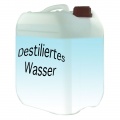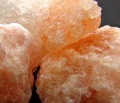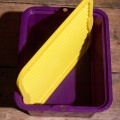GANS Production and Application: Unterschied zwischen den Versionen
| Zeile 1: | Zeile 1: | ||
[[File:Gans erstellung.jpg|thumb|rechts|Formation of GANS. Source: Keshe Foundation SSI, 2015]] | [[File:Gans erstellung.jpg|thumb|rechts|Formation of GANS. Source: Keshe Foundation SSI, 2015]] | ||
| − | GANS | + | GANS ist die Abkürzung für "'''GA'''s in '''N'''ano-state of '''S'''olid". Die Keshe Foundation hat ein Verfahren entwickelt, durch das Kohlenstoffdioxid (CO2) aus der Luft mit einfachen Mitteln extrahiert und in einen festen Zustand im Nanometerbereich (Nano-state of Solid) umgewandelt werden kann. Bei der Herstellung vom CO2-GANS wird der Kohlenstoff aus der Luft mit dem Sauerstoff in der Salzlösung in einer Art Plasma-Blase (aus Magnetischen und gravitativen Feldern) in eine besondere kristalline Form gebracht, wobei diese Kristalle das Licht (die Felder) absorbieren, speichern und bei „Bedarf“ abgeben. Jeder Kristall ist wie eine Sonne! |
| − | + | Des Weiteren hat die Keshe Foundation entdeckt, dass dieses GANS, sowohl getrocknet, als auch gebunden in Wasser, ein nützlicher Energielieferant ist, bzw. in Bereichen der Gesundheit und Landwirtschaft nützlich eingesetzt werden kann. Das aus dem GANS gewonnene GANS-Wasser (= das klare Wasser, das sich in der Suspension aus GANS und destilliertem Wasser über dem abgesetzten GANS befindet, nachdem das GANS mindestens 5 bis 10 Mal mit destilliertem Wasser „gewaschen“ wurde – siehe Kapitel GANS waschen) kann auf unterschiedliche Weise verwendet werden. Es lassen sich daraus z.B. Bäder und Wundauflagen machen. Es kann auch als Spray benutzt werden und in kleinen Mengen bzw. in verdünnter Form (Liquid Plasma – siehe dort) auch eingenommen werden. Die Anwendungen sind nahezu grenzenlos und erst ansatzweise erforscht. | |
| − | + | Das von der Keshe Foundation entwickelte Verfahren zur GANS-Gewinnung funktioniert nicht nur zur Erzeugung von CO2-GANS, sondern auch für andere "GANS-Arten". Die nebenstehende Abbildung zeigt schematisch die Entwicklung von GANS. Als Basis wird "rohes" Kupfer verwendet, abgebildet ist daher unten die kompakte Atomstruktur. Das Kupfer wird im ersten Schritt gecoatet. Durch das Coating entstehen die bereits erwähnten größeren Abstände zwischen den Atomen, es bilden sich Nanoschichten mit Nanowires (siehe Kapitel Coating). Dieses gecoatete Kupfer im Zusammenspiel mit einer Zinkplatte in Salzwasser das CO2-GANS, das sich am Boden absetzt. | |
| − | GANS | + | GANS wird zum Betrieb der Keshe-Magravs benötigt. Einerseits werden die gewickelten und gecoateten Spulen damit beschichtet, andererseits befinden sich GANS-Behälter (z.B. Ping-Pong Ball) in der Mitte der Spulen bzw. wird das GANS benötigt, um daraus GANS-Wasser und daraus wiederum GANS-Felder herzustellen. Diese GANS-Wässer sind in vielen Bereichen der Gesellschaft einsetzbar. Wir beschreiben hier lediglich die Herstellung der vier Grund-GANS-Arten durch Eintauchen von gecoateten Kupfer-Drähten bzw. gecoateten Kupfer-Platten und verschiedenen Metallen in 10%iges Meersalzwasser (100 Gramm Meersalz in 1l destilliertem Wasser aufgelöst). Somit benötigen Sie zur GANS-Gewinnung: |
Materials required for the production of GANS: | Materials required for the production of GANS: | ||
Version vom 18. März 2018, 12:39 Uhr
GANS ist die Abkürzung für "GAs in Nano-state of Solid". Die Keshe Foundation hat ein Verfahren entwickelt, durch das Kohlenstoffdioxid (CO2) aus der Luft mit einfachen Mitteln extrahiert und in einen festen Zustand im Nanometerbereich (Nano-state of Solid) umgewandelt werden kann. Bei der Herstellung vom CO2-GANS wird der Kohlenstoff aus der Luft mit dem Sauerstoff in der Salzlösung in einer Art Plasma-Blase (aus Magnetischen und gravitativen Feldern) in eine besondere kristalline Form gebracht, wobei diese Kristalle das Licht (die Felder) absorbieren, speichern und bei „Bedarf“ abgeben. Jeder Kristall ist wie eine Sonne!
Des Weiteren hat die Keshe Foundation entdeckt, dass dieses GANS, sowohl getrocknet, als auch gebunden in Wasser, ein nützlicher Energielieferant ist, bzw. in Bereichen der Gesundheit und Landwirtschaft nützlich eingesetzt werden kann. Das aus dem GANS gewonnene GANS-Wasser (= das klare Wasser, das sich in der Suspension aus GANS und destilliertem Wasser über dem abgesetzten GANS befindet, nachdem das GANS mindestens 5 bis 10 Mal mit destilliertem Wasser „gewaschen“ wurde – siehe Kapitel GANS waschen) kann auf unterschiedliche Weise verwendet werden. Es lassen sich daraus z.B. Bäder und Wundauflagen machen. Es kann auch als Spray benutzt werden und in kleinen Mengen bzw. in verdünnter Form (Liquid Plasma – siehe dort) auch eingenommen werden. Die Anwendungen sind nahezu grenzenlos und erst ansatzweise erforscht.
Das von der Keshe Foundation entwickelte Verfahren zur GANS-Gewinnung funktioniert nicht nur zur Erzeugung von CO2-GANS, sondern auch für andere "GANS-Arten". Die nebenstehende Abbildung zeigt schematisch die Entwicklung von GANS. Als Basis wird "rohes" Kupfer verwendet, abgebildet ist daher unten die kompakte Atomstruktur. Das Kupfer wird im ersten Schritt gecoatet. Durch das Coating entstehen die bereits erwähnten größeren Abstände zwischen den Atomen, es bilden sich Nanoschichten mit Nanowires (siehe Kapitel Coating). Dieses gecoatete Kupfer im Zusammenspiel mit einer Zinkplatte in Salzwasser das CO2-GANS, das sich am Boden absetzt.
GANS wird zum Betrieb der Keshe-Magravs benötigt. Einerseits werden die gewickelten und gecoateten Spulen damit beschichtet, andererseits befinden sich GANS-Behälter (z.B. Ping-Pong Ball) in der Mitte der Spulen bzw. wird das GANS benötigt, um daraus GANS-Wasser und daraus wiederum GANS-Felder herzustellen. Diese GANS-Wässer sind in vielen Bereichen der Gesellschaft einsetzbar. Wir beschreiben hier lediglich die Herstellung der vier Grund-GANS-Arten durch Eintauchen von gecoateten Kupfer-Drähten bzw. gecoateten Kupfer-Platten und verschiedenen Metallen in 10%iges Meersalzwasser (100 Gramm Meersalz in 1l destilliertem Wasser aufgelöst). Somit benötigen Sie zur GANS-Gewinnung:
Materials required for the production of GANS:
- Plastic container
- Distilled water
- Unrefined, natural sea or rock salt
- Nano-coated copper wires for short-circuiting of the metals
- Nano-coated copper plates or coils
- Various uncoated metal plates (zinc, copper, iron) which are needed for the production of different types of GANS'
This table gives an overview:
| GANS | Color | Coated Material | Uncoated Material | salt content |
|---|---|---|---|---|
| CO2 (ZnO + CO2) | cream white | nano-coated copper | zinc | 3-10% |
| ZnO | white | nano-coated zinc | zinc | 3-10% |
| CH3 (FeO + CH3) | reddish brown | nano-coated copper | zinccoated iron | 3-10% |
| CuO (CuO + Cu) | turquoise | nano-coated copper | copper | 3-10% |
IMPORTANT: When you produce your different GANSes, keep a distance (at least 3m, best 5m) between the different GANS-container. The closer the container, the more you get a mixture of different GANSes. Keep in mind, that through the selection of your different metals, you create a "magnet", which attracts the fields from the environment.




